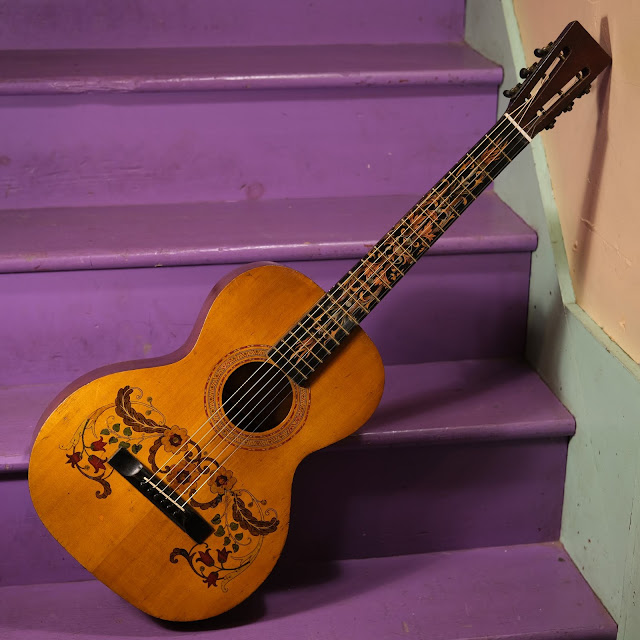1920s Oscar Schmidt Decalcomania 0-Size Guitar
Nothing else sounds quite like an old Oscar Schmidt (read: Stella, Sovereign) from the '20s. These sound like the blues -- or fingerpicked country -- or, ya know, wood and dust. This one's spruce over birch and and has the woody, warm, folksy vibe one expects from these. It handles beautifully under a flatpick or fingers -- which is something a lot of period guitars struggle to do. If you push on a lot of guitars from this age they compress or get zippy. These just lean into it and dish it back out.
Someone had done some work before me on this (a neck reset, old seam repairs, and bridge reglue), so my own work needed was a little lighter than usual. Still, it needed some fussing to make it "right." Post-fussing, it plays perfectly, has a straight neck, intonates nicely, and sounds killer.
The "special sauce" of this guitar, of course, is that it's decked-out in fantastic decals. The fretboard is full of them and the lower-bout is, too. It's vaguely-floral and there are neat parts of the decals that have a bit of an opalescent/iridescent quality to them that catch the light.
Repairs included: a fret level/dress, brace reglue jobs to back braces, new nut, fill/recut of the saddle slot, new compensated (synthetic) saddle, new bridge pins, side dots install, minor seam repairs, and setup.
Setup notes: it plays bang-on with 3/32" EA and 1/16" DGBE action at the 12th fret, has a straight neck, and is strung with 52w, 40w, 30w, 22w, 16, 12 gauges.
Scale length: 24 7/8"
Nut width: 1 7/8"
String spacing at nut: 1 5/8"
String spacing at bridge: 2 1/8"
Body length: 17 7/8"
Lower bout width: 13 1/2"
Waist width: 7 7/8"
Upper bout width: 9 3/4"
Side depth at endpin: 3 1/2"
Top wood: solid spruce
Back/sides wood: solid birch
Neck wood: poplar
Bracing type: ladder
Fretboard: ebonized maple, bone nut
Bridge: ebonized maple, compensated synthetic saddle
Neck feel: big C/soft V shape, flat board
Condition notes: it's mostly-original but does have a replacement saddle, replacement pins, and a replacement nut. The finish is all-original but does show average wear and tear throughout for the time with lots of smaller scratches and minor alligator to the finish here and there. The back of the neck may have gotten a shot of overspray but I'm not certain -- it has the texture of old finish and looks right but it's clean. Amazingly, it's crack-free but some old seam repairs were not done professionally and in a few places on the back/side seams there's a little overlap of the back beyond the sides. It's not obvious, though. Whoever reset the neck in the past shimmed-up the extension over the body but it doesn't match the board -- the shim wood is not colored the same as the extension and shows its seams. The tuners, also, rotate backwards from normal when tuning-up -- but one can just ignore that as they operate the same.



















Comments